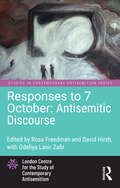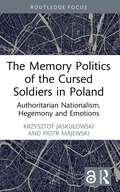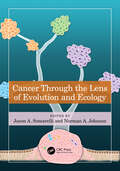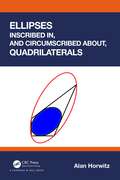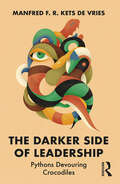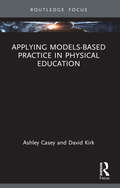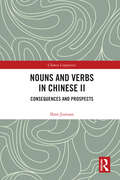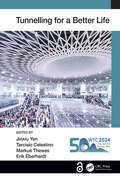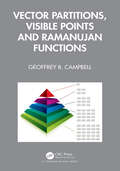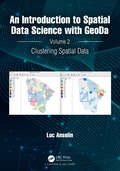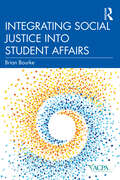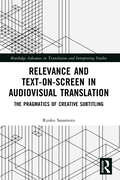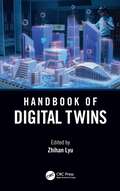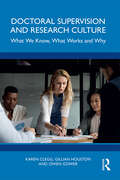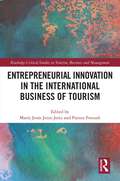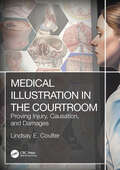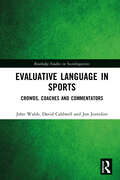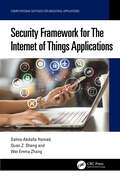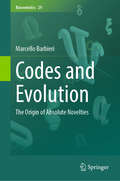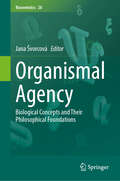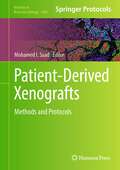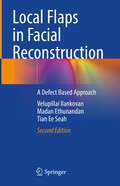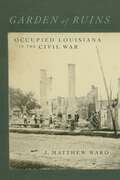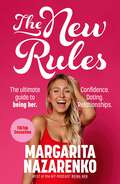- Table View
- List View
Responses to 7 October: Antisemitic Discourse (Studies in Contemporary Antisemitism)
by David Hirsh Rosa Freedman Odeliya Lanir ZafirOne of three volumes responding to the 7 October attack, Antisemitic Discourse focuses on the ideology that motivated it and the antisemitism that shaped many responses to it.It examines the provenance of the Jew-hatred, from English history to Palestinian Islamism; from toxic 19th century ‘Jewish Question’ rhetoric to the perversion of the Trotskyist tradition that allowed parts of the left to embrace antisemitism. It includes Howard Jacobson’s lecture of 22 October on antisemitism and it focuses on what was significant about this attack. There is discussion from Britain, Germany, Poland, and Norway, and a linguistic account of responses.This work will appeal to scholars, students and activists with an interest in antisemitism, Jewish studies and the politics of Israel.
The Memory Politics of the Cursed Soldiers in Poland: Authoritarian Nationalism, Hegemony and Emotions (Routledge Focus on the History of Conflict)
by Krzysztof Jaskułowski Piotr MajewskiThis book analyses right-wing memory politics in Poland through the concept of "cursed soldiers" as a key memory symbol, and how it has been used to construct a narrow and exclusionary vision of Polish identity framed in terms of Catholicism, national culture, and traditional family values.Groundbreaking in its approach and combining top-down study with reception analysis, the book builds on the theory of hegemony, adding emotional dimensions to the understanding of memory politics and nationalism. It provides a detailed case study of Polish memory politics since 2015, when the Law and Justice Party (PiS) came to power, and offers insights into how historical memory is used to mobilise support within nationalist and populist movements. Through a range of data including interviews, participant observation, and analysis of various media, it presents a semiotic and emotional map of how these memory symbols are received and experienced in Polish society. The focus on Podlasie, a region with significant Belarusian population and a history of post-war partisan conflicts, highlights the complex interplay of memory, identity, and politics in contemporary Poland.This work is intended for a broad audience, including undergraduates, postgraduates, scholars, and non-specialist readers such as booksellers or librarians.
Cancer through the Lens of Evolution and Ecology
by Norman A. Johnson Jason A. SomarelliCancer cells exist in an ever-changing “ecology” and are subject to evolutionary pressures just like any species in nature. This edited book explores the following themes: 1) how the dynamics of mutation, epigenetics, and gene expression noise are sources of genetic diversity; 2) how scarce resources influence cancer therapy resistance; 3) how predator-prey dynamics are mirrored in immune-cancer cross-talk; 4) how cancer cells parallel niche construction theory; 5) how changing fitness landscapes enable cancer growth; and 6) how cancer cells interact within the body. The book is a resource for understanding cancer as a disease of multicellularity grounded in evolutionary principles. By using this knowledge, researchers are starting to exploit these behaviors for treatment paradigms.Key Features Bridges disciplines exemplifying the ways disparate fields create new perspectives when integrated. Offers insights from leading scholars in cancer biology, ecology and evolutionary biology. Provides a timely recognition by oncologists that evolutionary paradigms are crucial for breakthroughs in cancer treatment. Integrates basic and applied sciences of oncology and evolutionary biology.
Ellipses Inscribed in, and Circumscribed about, Quadrilaterals
by Alan HorwitzThe main focus of this book is disseminating research results regarding the pencil of ellipses inscribing arbitrary convex quadrilaterals. In particular, the author proves that there is a unique ellipse of maximal area, EA, and a unique ellipse of minimal eccentricity, EI, inscribed in Q. Similar results are also proven for ellipses passing through the vertices of a convex quadrilateral along with some comparisons with inscribed ellipses. Special results are also given for parallelograms.Researchers in geometry and applied mathematics will find this unique book of interest. Software developers, image processors along with geometers, mathematicians, and statisticians will be very interested in this treatment of the subject of inscribing and circumscribing ellipses with the comprehensive treatment here.Most of the results in this book were proven by the author in several papers listed in the references at the end. This book gathers results in a unified treatment of the topics while also shortening and simplifying many of the proofs.This book also contains a separate section on algorithms for finding ellipses of maximal area or of minimal eccentricity inscribed in, or circumscribed about, a given quadrilateral and for certain other topics treated in this book.Anyone who has taken calculus and linear algebra and who has a basic understanding of ellipses will find it accessible.
The Darker Side of Leadership: Pythons Devouring Crocodiles
by Manfred F. Kets de VriesManfred Kets de Vries is one of the most authoritative voices on organizational dynamics, leadership, executive coaching, and psychotherapy today. In all his roles, he has noticed that questions are now, increasingly, coming back to one thing – the wider state of the world. Using an engaging and highly readable style throughout the book, Manfred helps us to make sense of the confusing and, some might say, psychotic times in which we now live.Revealing the darker side of leadership, Manfred explores the tendency for people to adopt ‘sheeple’ or herd-like behavior, the populist threat that we are facing, the dangers that come with feelings of perceived injustice, the rise of dictatorships, and the impact of Leviathan (neo-authoritarian) leadership behavior. Guided by theoretical concepts, the book provides readers with a better understanding of the underlying forces that drive these phenomena to the surface. What are the psychological dynamics at play? Why do groups of people behave in this manner? Beyond merely diagnosing what’s happening, Manfred introduces various coping strategies to counteract the emergence of these regressive forces.The book offers a unique and original approach to answering the micro- and macro-psychological questions of how to mitigate against populism and autocratic leadership, and will be of interest to the general reader as well as the key audiences of organizational leaders, psychoanalysts, coaches, psychotherapists, sociologists and social psychologists.
Applying Models-based Practice in Physical Education (Routledge Focus on Sport Pedagogy)
by David Kirk Ashley CaseyThis book is a concise, practical introduction to Models-based Practice (MbP), a transformative approach to physical education and sport pedagogy that uses multiple pedagogical models in the design and delivery of physical education programs.The book introduces the core concepts underpinning the MbP approach – including models such as teaching games for understanding, sport education, cooperative learning and health-based physical education – and examines its significance for teaching, learning, curriculum and assessment. With an emphasis on evidence-based practice and student learning, and full of practical tips and features to encourage critical thinking, the book explains how to develop successful, flexible and sustainable MbP programs that can deliver real educational and health and well-being benefits for children and young people, in schools or in after-school or community-based settings.Applying Models-based Practice in Physical Education is intended for current and prospective teachers of physical education who are responsible for organising and enacting programs at all grade levels. It will also be of interest to researchers, students and other sport pedagogy practitioners, such as coaches who are looking for new and innovative ways of working with children and young people.
Nouns and Verbs in Chinese II: Consequences and Prospects (ISSN)
by Shen JiaxuanAs the second volume of a two-volume set that re-examines nouns and verbs in Chinese, this book investigates a wide range of linguistic phenomena in Chinese and other languages to substantiate the verbs-as-nouns theory proposed by the author.In an attempt to break free from the shackles of Western linguistic paradigms, which are largely based on Indo-European languages and to a great extent inappropriate for Chinese, the two-volume set unravels the different relationships between nouns and verbs in Chinese, English, and other languages. This volume begins by looking at the problematic issues surrounding complements and adverbials in Chinese in order to explain the multifunctional nature of Chinese word classes. It then makes extensive use of evidence from other languages to explore the typology and evolution of word classes, as well as the cultural roots underlying the distinction between indicative and non-indicative negation in Chinese. In addition, it elucidates the significance and functions of monosyllabic and disyllabic combinations and the phenomenon of markedness reversal, shedding light on the subjectivity of the Chinese word class system.The volume is an important contribution to the study of Chinese linguistics, Chinese grammar, and contrastive linguistics.
Tunnelling for a Better Life
by Jinxiu YanTunnelling for a Better Life contain the contributions presented at the ITA-AITES World Tunnel Congress 2024, which was held from 19-25 April 2024 in Shenzhen, China. As urbanization accelerates, the pivotal role of tunnels and underground spaces in fostering environmental sustainability and improving quality of life becomes ever more pronounced. These underground structures serve as sustainable solutions to the challenges posed by rapid urban growth. By seamlessly integrating into urban landscapes, they alleviate congestion, reduce pollution, and enhance overall mobility, thus contributing to a greener and more sustainable urban environment. Moreover, tunnels and underground works provide vital support for various urban functions, such as accommodating economic activities, providing safe shelters during emergencies or disasters, and facilitating efficient utility management. They address immediate urban needs and lay the foundation for a better and more resilient future.By focusing on the latest trends in tunnelling and underground engineering, and looking ahead to the era of low-carbon and intelligent technology, the papers in this book illustrate the transformative potential of tunnels and underground works in shaping a better life for present and future generations. The contributions cover a comprehensive range of topics on tunnel engineering, showcasing the latest advancements, insights, and innovations across the following areas:1. Planning and General Aspects2. Design and Methodology3. Geotechnics, Geology and Geophysical Prospecting4. Ground Stability and Consolidation5. Support and Lining6. Conventional Tunnelling7. Mechanized Tunneling (TBM, shield)8. Immersed Tunnels9. Waterproofing and Drainage10. Instrumentation and Monitoring/ Testing and Inspection11. Digital and Information Technology12. Machine Learning13. Underground Caverns/Underground Space Use14. Operational Safety, Maintenance and Repair15. Contractual Practices and Risk ManagementTunnelling for a Better Life is a must-read for professionals, engineers, owners, and other stakeholders worldwide in tunnelling and underground engineering.
Vector Partitions, Visible Points and Ramanujan Functions
by Geoffrey B. CampbellVector Partitions, Visible Points and Ramanujan Functions offers a novel theory of Vector Partitions, though very much grounded in the long-established work of others, that could be developed as an extension to the existing theory of Integer Partitions. The book is suitable for graduate students in physics, applied mathematics, number theory and computational mathematics. It takes the reader up to research level, presenting new results alongside known classical results from integer partitions and areas of vector and multipartite partition theory. It also sets forth new directions for research for the more advanced reader.Above all, the intention of the book is to bring new inspiration to others who study mathematics and related areas. It is hoped that some new ideas will be launched to add value and insight into many of the classical and new theories surrounding partitions. The book is an appreciation of the many gifted authors of research into partitions over the past century and before, in the hope that more may come of this for future generations.Features Provides a step-by-step guide through the known literature on Integer and Vector Partitions, and a focus on the not so well-known Visible Point Vector identities Serves as a reference for graduate students and researchers in physics, applied mathematics, number theory and computational mathematics Offers a variety of practical examples as well as sets of exercises suitable for students and researchers Geoffrey B. Campbell completed his PhD at Australian National University in 1998 under the esteemed physicist Professor Rodney Baxter. His affiliation with the Australian National University Mathematical Sciences Institute has continued for over 30 years. Within that time frame, Geoffrey also served eight years as an Honorary Research Fellow at LaTrobe University Mathematics and Statistics Department in Melbourne. Currently he writes ongoing articles for the Australian Mathematical Society Gazette. Within the international scope, Geoffrey currently serves as a PhD external committee member for a mathematics graduate student at Washington State University in America.Geoffrey has built a career within Australian Commonwealth and State government departments, including as an Advisor at the Department of Prime Minister and Cabinet; as Analyst Researcher for a Royal Commission. Geoffrey specializes in complex data, machine learning including data analytics. He is also a published poet in Australian anthologies and literary magazines.
An Introduction to Spatial Data Science with GeoDa: Volume 2: Clustering Spatial Data
by Luc AnselinThis book is the second in a two-volume series that introduces the field of spatial data science. It moves beyond pure data exploration to the organization of observations into meaningful groups, i.e., spatial clustering. This constitutes an important component of so-called unsupervised learning, a major aspect of modern machine learning.The distinctive aspects of the book are both to explore ways to spatialize classic clustering methods through linked maps and graphs, as well as the explicit introduction of spatial contiguity constraints into clustering algorithms. Leveraging a large number of real-world empirical illustrations, readers will gain an understanding of the main concepts and techniques and their relative advantages and disadvantages. The book also constitutes the definitive user’s guide for these methods as implemented in the GeoDa open source software for spatial analysis.It is organized into three major parts, dealing with dimension reduction (principal components, multidimensional scaling, stochastic network embedding), classic clustering methods (hierarchical clustering, k-means, k-medians, k-medoids and spectral clustering), and spatially constrained clustering methods (both hierarchical and partitioning). It closes with an assessment of spatial and non-spatial cluster properties.The book is intended for readers interested in going beyond simple mapping of geographical data to gain insight into interesting patterns as expressed in spatial clusters of observations. Familiarity with the material in Volume 1 is assumed, especially the analysis of local spatial autocorrelation and the full range of visualization methods.Luc Anselin is the Founding Director of the Center for Spatial Data Science at the University of Chicago, where he is also Stein-Freiler Distinguished Service Professor of Sociology and the College, as well as a member of the Committee on Data Science. He is the creator of the GeoDa software and an active contributor to the PySAL Python open-source software library for spatial analysis. He has written widely on topics dealing with the methodology of spatial data analysis, including his classic 1988 text on Spatial Econometrics. His work has been recognized by many awards, such as his election to the U.S. National Academy of Science and the American Academy of Arts and Science.
Integrating Social Justice into Student Affairs
by Brian BourkePushing back on the critique that social justice is often just a buzzword in student affairs, this book provides guidance on how to truly make social justice a fundamental part of student affairs.Shaped by voices of student affairs educators and up-to-date literature, Bourke offers guidance on how to approach social justice effectively and confidently as a student affairs educator. This book provides discussion of the core concepts connected to social justice, strategies for making social justice part of one's practice, and guidance on how to infuse social justice into practice throughout the field. Each chapter features reflection and discussion questions, as well as suggestions for further reading aiming to provide readers with fresh perspectives on how to center social justice in student affairs.Filled with extensive research, practical measures, and engaging prompts, this book serves as a launchpad for student affairs educators to be intentional with their practice and put words into action.
Relevance and Text-on-Screen in Audiovisual Translation: The Pragmatics of Creative Subtitling (ISSN)
by Ryoko SasamotoThis book examines audiovisual translation (AVT) practices that fall outside conventional AVT norms, drawing on work from relevance theory to highlight alternative perspectives and make the case for a multidisciplinary approach to AVT.The volume focuses on creative subtitling – otherwise known as 'text-on-screen' – through the lens of relevance theory, a cognitively grounded theory of communication. Sasamoto explores the ways in which a relevance theoretic approach can provide an analytical framework for a better understanding of the interaction between 'text-on-screen' and viewers' interpretation processes and, in turn, how media producers, professional or otherwise, use 'text-on-screen' to engage viewers in innovative ways. The volume looks at such forms as telop, creative text use on screen, and forms of user-generated text-on-screen.The book introduces a new dimension to work on cognative pragmatics and the wider applications of relevance theory in multimodal communication and AVT, making it of interest to scholars in these disciplines.
Handbook of Digital Twins
by Zhihan LyuOver the last two decades, Digital Twins (DTs) have become the intelligent representation of future development in industrial production and daily life. Consisting of over 50 chapters by more than 100 contributors, this comprehensive handbook explains the concept, architecture, design specification and application scenarios of DTs.As a virtual model of a process, product or service to pair the virtual and physical worlds, DTs allow data analysis and system monitoring by using simulations. The fast-growing technology has been widely studied and developed in recent years. Featured with centralization, integrity and dynamics, it is cost-effective to drive innovation and performance. Many fields saw the adaptation and implementation across industrial production, healthcare, smart city, transportation and logistics. World-famous enterprises such as Siemens, Tesla, ANSYS and General Electric have built smart factories and pioneered digital production, heading towards Industry 4.0.This book aims to provide an in-depth understanding and reference of DTs to technical personnel in the field, students and scholars of related majors, and general readers interested in intelligent industrial manufacturing.
Pesticide Toxicology and Risk Assessment: Linking Exposure to Biological Effects
by Muneeb U. Rehman Adil Farooq Wali Vani BajajWith the emergence of new pesticide combinations and application methods, assessing their potential risks to non-target organisms and human well-being becomes paramount. Pesticide Toxicology and Risk Assessment focuses on the need and strategies for safe and efficient use of pesticides. It offers insights from toxicogenomics, enabling an understanding of the genetic and epigenetic factors influencing human susceptibility to chemical toxicity, thereby quantifying their impacts.This book underscores the significance of risk assessment methodologies considering real-time variables influencing pesticide exposure to the environment and humans. It provides comprehensive details about models designed to evaluate risks across a spectrum of scenarios, from worst-case to real-time situations, while outlining strategies to mitigate these risks proactively. Furthermore, this book delves into the critical need for conducting field studies, particularly in addressing innovative combinations and application techniques.Key Features:• Covers toxicogenomic insights, delving into genetic and epigenetic impacts on human susceptibility to chemical toxicity• Provides insight into necessary field studies for new pesticide approaches• Aids pesticide manufacturers with risk assessment and effective formulation insightsAs an aid for regulatory bodies, the book facilitates the evaluation of risks linked to both established and innovative pesticides, promoting informed decisions on usage by integrating risk reduction approaches. Simultaneously, it serves as a valuable guide for pesticide manufacturers, offering insights into using risk assessment tools to develop secure and effective pesticide blends. This guidance expedites the introduction of novel pesticides that are efficient and safe for various applications.
Doctoral Supervision and Research Culture: What We Know, What Works and Why
by Karen Clegg Owen Gower Gillian HoustonDrawing on original survey data, reflective accounts, and case studies of supervisory practice in different disciplines, Doctoral Supervision and Research Culture explores the supervisor experience and demonstrates the craft, compassion and consistency required of supervisors in responding to different researcher’s needs.Based on empirical data and using the voice of research supervisors, the authors throw a spotlight on the challenges and opportunities supervisors face in supporting doctoral researchers through to successful PhD completion. This book acts as an invitation to institutions, funders, industry and academics to review what, and how they support PhD provision and to elevate the status of supervision practice. It shows how research cultures - disciplinary, institutional and individual - affect the supervisory experience and highlight the challenges that supervisors face, as well as the rewards that successful supervisory relationships bring. It is also a celebration of the contribution that doctoral researchers and all those who support research make to society. Designed to provide opportunities for sharing of practice across disciplines and the sector, Doctoral Supervision and Research Culture will be of interest to both new and experienced supervisors, to staff and researcher developers in institutions, and to funders, policy makers and senior management in universities who seek to improve and enhance the supervisory experience for all agents.
Entrepreneurial Innovation in the International Business of Tourism (Routledge Critical Studies in Tourism, Business and Management)
by Pantea Foroudi María Jesús Jerez-JerezThis international case study book provides 28 expertly curated case studies on entrepreneurship and innovation in tourism, each with detailed implementation instructions for the instructor to maximise student participation and learning.The dynamic characteristic of the tourism industry under the influence of micro and macro environment factors requires future professionals to be equipped with appropriate skills and competencies to deal with change and development in real-life practices. Curated and developed by industry experts and practitioners, these case studies embody real-world scenarios with the aim of best preparing students for their future careers. This compelling set of case studies explores the dynamics of entrepreneurship in global context, analyses emerging markets and new business models, and elicits the implications of innovation and entrepreneurship in different contexts and within a transdisciplinary perspective. The cases illustrate innovation and entrepreneurship as an accelerator of tourism growth and development, under a sustainable perspective.With reflective questions throughout to aid both in-class discussion and self-study, this book is an ideal study resource for use in higher and vocational education, and its unique, teaching-led approach positions it as a vital study tool for instructors and students alike.
Medical Illustration in the Courtroom: Proving Injury, Causation, and Damages
by Lindsay E. CoulterMedical Illustration in the Courtroom: Proving Injury, Causation, and Damages educates the reader on how to communicate science visually—in personal injury, medical malpractice, criminal, and forensic cases—by creating art that utilizes medical records, radiographs, and computer software. Medical illustration bridges the gap between complex technical, medical, and scientific concepts to clearly illustrate, and explain visually, a medical condition, negligence, or the causation of an injury or death to the lay person. Medical artists are frequently challenged with illustrating injuries and medical conditions that can’t be seen by the naked eye. And while using medical photography and imaging for illustrative purposes can be helpful, to an untrained eye it can often be unclear or confusing. This is where the medical illustrator enters the equation. There are often patients who have recovered from an injury or infection that appear in good health. However, should an unforeseen injury or fatality happen, medical illustrators can reveal to people what’s actually going on inside the person, an invaluable asset to attorneys in the courtroom—especially for personal injury and medical malpractice cases. While many attorneys utilize medical artists, nonvisual people don’t always recognize the value of demonstrative aids until they see them first-hand.When attorneys and their clients enlist the aid of medical artists, it quickly becomes apparent that properly conceived and executed artwork is invaluable to illustrating the facts—and medical impacts—of any number of scenarios: homicides by shooting, stabbings, vehicular accidents, in addition to medical malpractice and personal injuries resulting from surgery or possible negligence.Presenting a myriad of services and computer technologies that can be utilized, Medical Illustration in the Courtroom provides demonstrative aids used in cases to illustrate personal injury and medical malpractice, employing "tricks of the trade" to create an accurate effective image. Such images are educational to attorneys, insurance adjusters, judges, and juries to help create a visual storyline, the goal being to help combine art and science to provide a clear illustration of events to help in adjudicate legal and forensic cases.
Evaluative Language in Sports: Crowds, Coaches and Commentators (Routledge Studies in Sociolinguistics)
by John Walsh David Caldwell Jon JureidiniWalsh, Caldwell and Jureidini offer an expansive linguistic perspective on the evaluative language prevalent in the world of professional sports.This book presents a close linguistic analysis of evaluative language in sport. Drawing on appraisal theory and data from three distinct sporting contexts – songs and chants in football stadiums, television commentary and coach discourse – it examines the critical role played by affectual, judgemental and appreciative language. In the spirit of sociolinguistics, this book also considers the history and culture of the respective sporting contexts. Connections are made between the evaluative language expressed by supporters, commentators and coaches and the invocation of power and solidarity. Evaluative Language in Sports gives insight into some of the key language practices that contribute to professional sports culture: a communal and combative world of winners and losers, ‘us and ‘them’.An innovative and valuable book that will appeal to students, researchers and sports enthusiasts interested in sports communication and language, sociolinguistics and media studies.
Security Framework for The Internet of Things Applications (Computational Methods for Industrial Applications)
by Quan Z. Sheng Wei Emma Zhang Salma Abdalla HamadThe text highlights a comprehensive survey that focuses on all security aspects and challenges facing the Internet of Things systems, including outsourcing techniques for partial computations on edge or cloud while presenting case studies to map security challenges. It further covers three security aspects including Internet of Things device identification and authentication, network traffic intrusion detection, and executable malware files detection.This book: Presents a security framework model design named Behavioral Network Traffic Identification and Novelty Anomaly Detection for the IoT Infrastructures Highlights recent advancements in machine learning, deep learning, and networking standards to boost Internet of Things security Builds a near real-time solution for identifying Internet of Things devices connecting to a network using their network traffic traces and providing them with sufficient access privileges Develops a robust framework for detecting IoT anomalous network traffic Covers an anti-malware solution for detecting malware targeting embedded devices It will serve as an ideal text for senior undergraduate and graduate students, and professionals in the fields of electrical engineering, electronics and communication engineering, computer engineering, and information technology.
Codes and Evolution: The Origin of Absolute Novelties (Biosemiotics #29)
by Marcello BarbieriThis text builds upon the over 1500 papers published in peer-reviewed journals revealing that there are more than 200 biological codes in living systems. The author claims this experimental fact is bound to change biology forever. This book shows how this very discovery reveals that coding is a new mechanism of life, just as the discovery of electromagnetism revealed the existence of a new physical force in the universe. The existence of many biological codes, furthermore, Barbieri argues, is one of those experimental facts that have extraordinary theoretical consequences. It implies that coding is not only a mechanism that constantly operates in all living systems, but also a mechanism of evolution, more precisely a mechanism that gave origin to the absolute novelties of the history of life. This amounts to saying that evolution took place by two distinct mechanisms, by natural selection and by natural conventions, two mechanisms that are fundamentally different because natural selection is the result of copying and deals with information whereas natural conventions are the result of coding and deal with meaning. This volume appeals to students and researchers working in the fields of semiotics, philosophy, biology and mathematics.
Organismal Agency: Biological Concepts and Their Philosophical Foundations (Biosemiotics #28)
by Jana ŠvorcováThis book explores the notion of organismal agency from the perspective of both philosophy and biology. The two sections of the book delve into parallel themes, including distinctions between organic and inorganic nature, self-organization, autonomy, self-presentation, memory, umwelt, and environmental influence. The philosophical part focuses on the influential thinkers who shaped our perception of living entities beyond mere mechanisms. It scrutinizes the concepts of organism and nature in the works of Aristotle, Kant, Schelling, and various processualists. Each chapter explores facets of their ideas that directly or indirectly foreshadowed or contributed to the formulation of the concept of agency. The biological part of the book investigates various concepts associated with agency such as experience, meaning attribution, and phenotypic plasticity, as well as reproduction, organisational constraints, modularity, development of integrated phenotypes, organismal choices, or self-representation through animal organisation. In essence, this work offers a comprehensive examination of organismal agency and its philosophical and biological foundations. Collaboratively authored by individuals from several institutions, this publication caters primarily to researchers and students working at the intersection of philosophy and biology.
Patient-Derived Xenografts: Methods and Protocols (Methods in Molecular Biology #2806)
by Mohamed I. SaadThis detailed volume explores the dynamic landscape of patient-derived xenograft (PDX) generation and applications. After a few chapters examining the evolution of PDXs, tracing their roots and contextualizing their significance in the broader narrative of cancer research, the book continues with methodologies for generating PDXs from diverse clinical tissue samples as well as for utilizing PDXs in various specific cancer types. From the development of humanized PDX models to the exploration of protein expression through advanced techniques including multiplex immunohistochemistry, Western blotting, and immunoprecipitation, the chapters offer a comprehensive toolkit for researchers and clinicians alike. Written for the highly successful Methods in Molecular Biology series, chapters include introductions to their respective topics, lists of the necessary materials and reagents, step-by-step and readily reproducible laboratory protocols, and tips on troubleshooting and avoiding known pitfalls. Authoritative and practical, Patient-Derived Xenografts: Methods and Protocols serves as an ideal interdisciplinary guide for understanding the intricate processes that underscore translational cancer research.
Local Flaps in Facial Reconstruction: A Defect Based Approach
by Velupillai Ilankovan Madan Ethunandan Tian Ee SeahWritten by three consultants with extensive skin cancer experience and international reputations for excellence, this book provides comprehensive practical solutions for defects in the head and neck region that clinicians are confronted with in day-to-day practice. The first edition of the “local flaps in facial reconstruction- a defect base approach” was published nearly four years ago and has since been well received around the world and translated into other languages. This second edition is intended to facilitate the decision-making process and provide practical,step-by-step guidance on reconstructing specific defects in the facial region.The frequency of skin cancer continues to rise around the globe, and clinicians with various backgrounds are involved in the care of these patients. In this book, new procedures are described and “old” ones re-evaluated. The current edition has been extensively updated with new text and diagrams so as to provide comprehensive practical solutions for frequently encountered facial defects. Color diagrams and clinical photographs have been included where necessary to provide additional details. The original ethos of creating a text that can be used in everyday practice, while also including personal comments, is maintained.Given the scope, the book is ideal for use by clinicians and trainees in daily practice, and will help to achieve excellent cosmetic outcomes in this aesthetically sensitive part of the body.
Garden of Ruins: Occupied Louisiana in the Civil War (Conflicting Worlds: New Dimensions of the American Civil War)
by J. Matthew WardJ. Matthew Ward’s Garden of Ruins serves as an insightful social and military history of Civil War–era Louisiana. Partially occupied by Union forces starting in the spring of 1862, the Confederate state experienced the initial attempts of the U.S. Army to create a comprehensive occupation structure through military actions, social regulations, the destabilization of slavery, and the formation of a complex bureaucracy. Skirmishes between Union soldiers and white civilians supportive of the Confederate cause multiplied throughout this period, eventually turning occupation into a war on local households and culture. In unoccupied regions of the state, Confederate forces and their noncombatant allies likewise sought to patrol allegiance, leading to widespread conflict with those they deemed disloyal. Ward suggests that social stability during wartime, and ultimately victory itself, emerged from the capacity of military officials to secure their territory, governing powers, and nonmilitary populations. Garden of Ruins reveals the Civil War, state-building efforts, and democracy itself as contingent processes through which Louisianans shaped the world around them. It also illustrates how military forces and civilians discovered unique ways to wield and hold power during and immediately after the conflict.
The New Rules
by Margarita NazarenkoWe all want to live the best life we can, but how do we sort through all the confusing messages about how to do that?Margarita Nazarenko tells it like it is when it comes to women and relationships - and women's relationships with themselves. A qualified life coach, YouTuber and TikTok sensation, Margarita advises women not only about how to navigate relationships with men, but how to create wonderful lives with or without a relationship.Her message is straightforward: don't expect to have a great life if you're not creating it for yourself first.The New Rules collects the wisdom Margarita has shared with her followers all over the world as well as new insights - and a bit about Margarita herself - in her unique and inimitable style. Margarita is agony aunt, big sister and best friend rolled into one, and this book is a portable best friend that women can carry with them throughout the day - and throughout life
